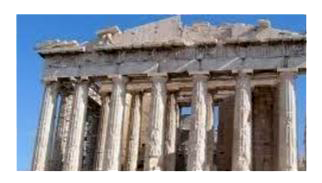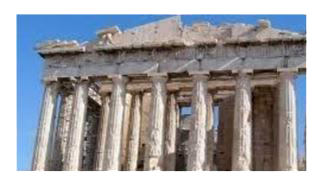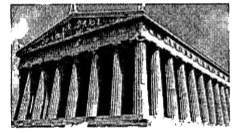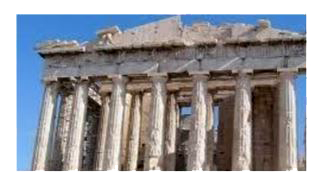Marble’s popularity began in ancient Rome and Greece, where white and off-white marble were used to construct a variety of structures, from hand-held sculptures to massive pillars and buildings.

Marble statues are corroded or stained rain water. Identify the main reason

decomposition of calcium carbonate to calcium oxide
polluted water is basic in nature hence it reacts with calcium carbonate
polluted water is acidic in nature he
calcium carbonate dissolves in water to give calcium hydroxide.
The correct Answer is:B
Chemically, marble is Calcium Carbonate.
The atmosphere contains many oxides, which dissolve in water forming acids like sulfuric, nitric which are common due to modern pollution. Even carbon dioxide forms carbonic acid which also does damage.
These will react with marble and result in formation of calcium salt, carbon dioxide and water. So, under extended periods, the wear of marble statues is expected.
Topper's Solved these Questions
- BOOK - OSWAL PUBLICATIONCHAPTER - CHEMICAL REACTIONS AND EQUATIONSEXERCISE - ASSERTION AND REASON BASED MCQs8videos
CHEMICAL REACTIONS AND EQUATIONS
- BOOK - OSWAL PUBLICATIONCHAPTER - CHEMICAL REACTIONSEXERCISE - BOARD CORNER (Short Answer Type Questions)3videos
CHEMICAL REACTIONS
- BOOK - OSWAL PUBLICATIONCHAPTER - DIKSHA QUESTIONS EXERCISE - PERIODIC CLASSIFICATION OF ELEMENTS (MULTIPLE CHOICE QUESTIONS)13videos
DIKSHA QUESTIONS
Similar Questions
Marble’s popularity began in ancient Rome and Greece, where white and off-white marble were used to construct a variety of structures, from hand-held sculptures to massive pillars and buildings.

The substance not likely to contain CaCO3 isView SolutionMarble’s popularity began in ancient Rome and Greece, where white and off-white marble were used to construct a variety of structures, from hand-held sculptures to massive pillars and buildings.

Gas A, obtained above is a reactant for a very important biochemical process which occurs in the presence of sunlight. Identify the name of the processView Solution
Knowledge Check
- Question 1 - Select One
Read the following and answer the question.
Marble's popularity began in ancient Rome and Greece, where white and off-white marble were used to construct a variety of structures, from hand held sculptures to massive pillars and buildings.

Gas A, obtained above is a reactant for a very important biochemical process which occurs in the presence of sunlight. Identify the name of the process -ARespirationBPhotosynthesisCTranspirationDPhotolysis - Question 2 - Select One
The Mayan Indians lived in Mexico thousands of years before the Spanish arrived in the 1500s. The Mayan's were an intelligent, culturally rich people whose achievements were many. They had farms, beautiful places and cities with many buildings. The Maya's knew a lot about nature and the world around them. This knowledge helped them to live a better life than most people of that time because they could use it to make their lives more comfortable and rewarding. Knowledge about tools and farming for instance, made their work easier and more productive.
The Maya's believed in many gods, including Rain God, Sun God and Corn God. They built large temples to honour their gods.
Skilful workers built cities around these temples. It was difficult for them to construct these cities because they had no horses to carry the heavy stones they used to build with. Workers had to carty all of the building materiais themselves. Today, many of these ancient Mayan cities and temples are still standing. Although the cities that the Maya's built were beautiful and the people worked hard to build them very few of the people lived in them. Usually, only the priests lived in the cities.
The other people lived in small villages in the forest. Their houses were much simpler than the elaborate structures in the cities. They lived in small huts with no windows, The walls were made of poles covered with dried mud and the roof was made of grass or leaves. Most Maya's lived a simple life close to nature.
The Mayan priests studied the Sun, Moon, Stars and Planets. They made a calendar from what they had learnt. The year was divided into 18 months of 20 days each with 5 days left over. The Mayan calendar was more accurate than the European calendars of the time.
Around the year 800, the Maya's left their villages and beautiful cities, never to return. No one knows why this happened. They may have died from an infectious disease. They may have left because the soil could no longer grow crops. Archaeologists are still trying to find the lost secrets of the maya's. They are still one of our greatest mysteries.
What is the main idea of this passage?AThe Mayan calendar was more accurate than the European calenderBThe Maya's were excellent farmers and hard working peopleCThe Maya's were a culturally rich and an advanced societyDThe Maya's cities and temples were difficult to build - Question 3 - Select One
The Mayan Indians lived in Mexico thousands of years before the Spanish arrived in the 1500s. The Mayan's were an intelligent, culturally rich people whose achievements were many. They had farms, beautiful places and cities with many buildings. The Maya's knew a lot about nature and the world around them. This knowledge helped them to live a better life than most people of that time because they could use it to make their lives more comfortable and rewarding. Knowledge about tools and farming for instance, made their work easier and more productive.
The Maya's believed in many gods, including Rain God, Sun God and Corn God. They built large temples to honour their gods.
Skilful workers built cities around these temples. It was difficult for them to construct these cities because they had no horses to carry the heavy stones they used to build with. Workers had to carty all of the building materiais themselves. Today, many of these ancient Mayan cities and temples are still standing. Although the cities that the Maya's built were beautiful and the people worked hard to build them very few of the people lived in them. Usually, only the priests lived in the cities.
The other people lived in small villages in the forest. Their houses were much simpler than the elaborate structures in the cities. They lived in small huts with no windows, The walls were made of poles covered with dried mud and the roof was made of grass or leaves. Most Maya's lived a simple life close to nature.
The Mayan priests studied the Sun, Moon, Stars and Planets. They made a calendar from what they had learnt. The year was divided into 18 months of 20 days each with 5 days left over. The Mayan calendar was more accurate than the European calendars of the time.
Around the year 800, the Maya's left their villages and beautiful cities, never to return. No one knows why this happened. They may have died from an infectious disease. They may have left because the soil could no longer grow crops. Archaeologists are still trying to find the lost secrets of the maya's. They are still one of our greatest mysteries.
The Maya's were an intelligent, culturally rich people whose achievements were many
'Achievement', here meansAskillsBsuccessesCinnovationsDsecrets
Marble’s popularity began in ancient Rome and Greece, where white and off-white marble were used to construct a variety of structures, from hand-held sculptures to massive pillars and buildings.

Calcium oxide can be reduced to calcium, by heating with sodium metal. Which compound would act as an oxidizing agent in the above processView SolutionMarble’s popularity began in ancient Rome and Greece, where white and off-white marble were used to construct a variety of structures, from hand-held sculptures to massive pillars and buildings.

A student added 10g of calcium carbonate in a rigid container, secured it tightly and started to heat it. After some time, an increase in pressure was observed, the pressure reading was then noted at intervals of 5 mins and plotted against time, in a graph as shown below. During which time interval did maximum decomposition took place?
 View Solution
View SolutionThe Mayan Indians lived in Mexico thousands of years before the Spanish arrived in the 1500s. The Mayan's were an intelligent, culturally rich people whose achievements were many. They had farms, beautiful places and cities with many buildings. The Maya's knew a lot about nature and the world around them. This knowledge helped them to live a better life than most people of that time because they could use it to make their lives more comfortable and rewarding. Knowledge about tools and farming for instance, made their work easier and more productive.
The Maya's believed in many gods, including Rain God, Sun God and Corn God. They built large temples to honour their gods.
Skilful workers built cities around these temples. It was difficult for them to construct these cities because they had no horses to carry the heavy stones they used to build with. Workers had to carty all of the building materiais themselves. Today, many of these ancient Mayan cities and temples are still standing. Although the cities that the Maya's built were beautiful and the people worked hard to build them very few of the people lived in them. Usually, only the priests lived in the cities.
The other people lived in small villages in the forest. Their houses were much simpler than the elaborate structures in the cities. They lived in small huts with no windows, The walls were made of poles covered with dried mud and the roof was made of grass or leaves. Most Maya's lived a simple life close to nature.
The Mayan priests studied the Sun, Moon, Stars and Planets. They made a calendar from what they had learnt. The year was divided into 18 months of 20 days each with 5 days left over. The Mayan calendar was more accurate than the European calendars of the time.
Around the year 800, the Maya's left their villages and beautiful cities, never to return. No one knows why this happened. They may have died from an infectious disease. They may have left because the soil could no longer grow crops. Archaeologists are still trying to find the lost secrets of the maya's. They are still one of our greatest mysteries.
Many Mayan cities and temples can be found in good shape even today because theyView SolutionThe Mayan Indians lived in Mexico thousands of years before the Spanish arrived in the 1500s. The Mayan's were an intelligent, culturally rich people whose achievements were many. They had farms, beautiful places and cities with many buildings. The Maya's knew a lot about nature and the world around them. This knowledge helped them to live a better life than most people of that time because they could use it to make their lives more comfortable and rewarding. Knowledge about tools and farming for instance, made their work easier and more productive.
The Maya's believed in many gods, including Rain God, Sun God and Corn God. They built large temples to honour their gods.
Skilful workers built cities around these temples. It was difficult for them to construct these cities because they had no horses to carry the heavy stones they used to build with. Workers had to carty all of the building materiais themselves. Today, many of these ancient Mayan cities and temples are still standing. Although the cities that the Maya's built were beautiful and the people worked hard to build them very few of the people lived in them. Usually, only the priests lived in the cities.
The other people lived in small villages in the forest. Their houses were much simpler than the elaborate structures in the cities. They lived in small huts with no windows, The walls were made of poles covered with dried mud and the roof was made of grass or leaves. Most Maya's lived a simple life close to nature.
The Mayan priests studied the Sun, Moon, Stars and Planets. They made a calendar from what they had learnt. The year was divided into 18 months of 20 days each with 5 days left over. The Mayan calendar was more accurate than the European calendars of the time.
Around the year 800, the Maya's left their villages and beautiful cities, never to return. No one knows why this happened. They may have died from an infectious disease. They may have left because the soil could no longer grow crops. Archaeologists are still trying to find the lost secrets of the maya's. They are still one of our greatest mysteries.
The Maya's lived in MexicoView SolutionThe Mayan Indians lived in Mexico thousands of years before the Spanish arrived in the 1500s. The Mayan's were an intelligent, culturally rich people whose achievements were many. They had farms, beautiful places and cities with many buildings. The Maya's knew a lot about nature and the world around them. This knowledge helped them to live a better life than most people of that time because they could use it to make their lives more comfortable and rewarding. Knowledge about tools and farming for instance, made their work easier and more productive.
The Maya's believed in many gods, including Rain God, Sun God and Corn God. They built large temples to honour their gods.
Skilful workers built cities around these temples. It was difficult for them to construct these cities because they had no horses to carry the heavy stones they used to build with. Workers had to carty all of the building materiais themselves. Today, many of these ancient Mayan cities and temples are still standing. Although the cities that the Maya's built were beautiful and the people worked hard to build them very few of the people lived in them. Usually, only the priests lived in the cities.
The other people lived in small villages in the forest. Their houses were much simpler than the elaborate structures in the cities. They lived in small huts with no windows, The walls were made of poles covered with dried mud and the roof was made of grass or leaves. Most Maya's lived a simple life close to nature.
The Mayan priests studied the Sun, Moon, Stars and Planets. They made a calendar from what they had learnt. The year was divided into 18 months of 20 days each with 5 days left over. The Mayan calendar was more accurate than the European calendars of the time.
Around the year 800, the Maya's left their villages and beautiful cities, never to return. No one knows why this happened. They may have died from an infectious disease. They may have left because the soil could no longer grow crops. Archaeologists are still trying to find the lost secrets of the maya's. They are still one of our greatest mysteries.
Most Maya's lived inView Solution
